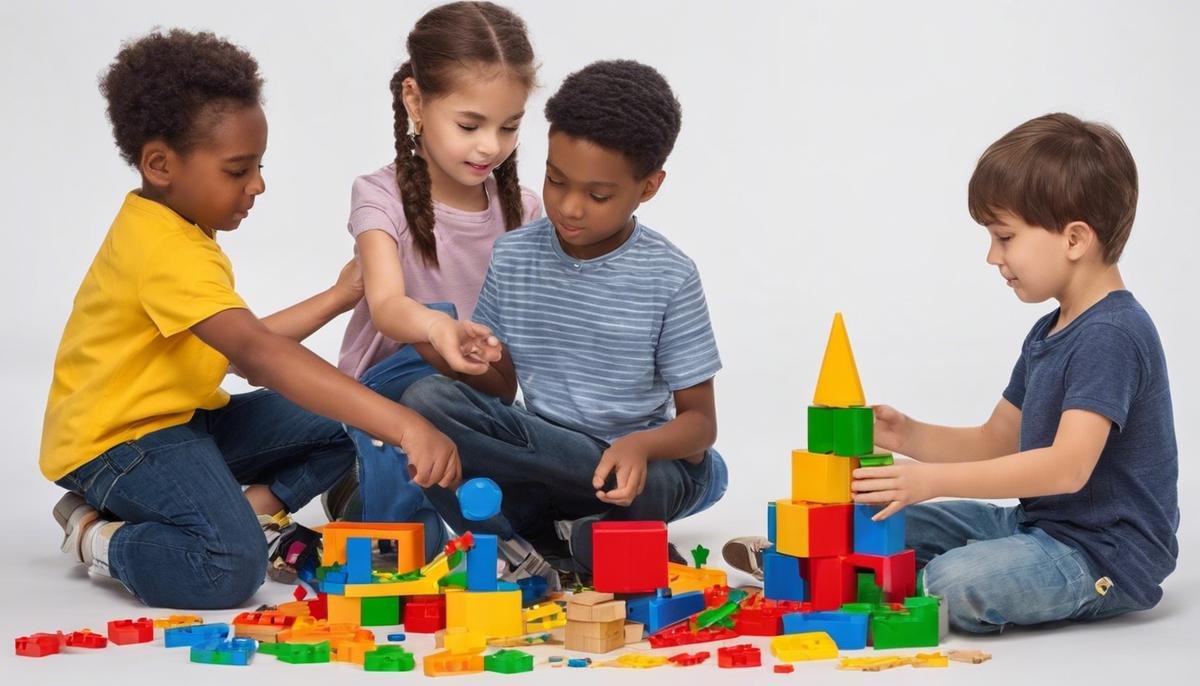
In the vast landscape of human experiences, Autism is a complex and diverse spectrum disorder that deserves our attention and understanding. Like the facets of a multi-dimensional crystal, each autistic child reflects different shades and aspects of Autism, defining their unique journey. Parents, educators, and caretakers must become well-versed in recognizing the subtle nuances, including the concept of Monotropism, often a significant yet overlooked aspect in this context. By developing an understanding of these factors, we can empower autistic children and help them thrive.
As we navigate through this eye-opening exploration, we will shed light on Autism and its intricate details, delve into the world of Monotropism, its connection to Autism and its profound implications. We will also offer strategies for managing monotropism and share anecdotes from those who have made this journey before us. This endeavor is not just about gaining knowledge, it’s about fostering empathy, showing support, and above all, letting those on the Autism spectrum and their families know they are not alone.
Understanding Autism
Every Parent’s Guide to Understanding Autism
Autism, often referred to as Autism Spectrum Disorder (ASD), affects individuals in different ways, making it a complex and often misunderstood condition. Having an open conversation about autism is paramount for every parent, regardless of whether your child is on the spectrum or not. For a family lifestyle enriched with understanding, acceptance, and support, here’s what every parent should know about autism.
Autism is a Spectrum
First and foremost, it’s essential to remember that autism is a spectrum. This means that no two individuals living with autism are identical – the challenges, strengths, and needs of each individual vary significantly. Some individuals might be completely independent, while others require more assistance with daily tasks. Understanding that autism enjoys such a wide spectrum helps cultivate empathy and understanding towards individuals living with ASD.
Recognize the Early Signs
Early intervention can make a world of difference in parenting a child with autism. Recognizing the early signs of autism and acting upon them can provide your child with supportive tools and strategies to thrive. Delayed speech development, limited eye contact, or repetitive behaviors are some things to look out for in the early years. Remember, these factors might not necessarily indicate autism, but if persistent, seek advice from a healthcare professional.
Celebrate Their Unique Abilities
Children with autism often have strengths and talents that far outshine their challenges. From art and music skills to extraordinary memory and attention to detail, these unique abilities should be celebrated, just like the abilities of any child. Recognizing and fostering these talents is a crucial part of parenting, which helps in reinforcing their self-esteem and independence.
Autism Isn’t a Disease
Autism isn’t a disease to be treated; it’s a different way of experiencing the world. Children with autism perceive things differently, learn differently, and interact differently. Along with being patient, fostering an environment that respects their unique approach to world interaction is essential.
Seek Support and Community
Parenting a child with autism can feel overwhelming sometimes. But, remember, you are not alone on this journey. Many organizations offer resources, and numerous online communities provide invaluable support and guidance. Connecting with these groups can equip you with the knowledge you need, and provide an understanding shoulder when things get a bit difficult.
In Conclusion
Every child has the right to be cherished, celebrated, and accepted for who they are. When parenting a child with ASD, this doesn’t change; it only requires a bit more understanding, patience, and an extra sprinkling of love. Autism awareness and understanding should be a part of every parent’s life, fostering a community that appreciates the beauty of diversity, the joy of unique talents, and the strength in standing together. After all, isn’t building a world of unconditional love and acceptance the paramount aspect of parenting?

Breaking Down Monotropism
Unraveling Monotropism: A New Perspective on Autism
Autism, an ever-evolving spectrum, presents itself in myriad ways, each as unique as the individual it affects. Amidst the signs, symptoms, and characteristics, there’s one term that often gets lost in the whirlwind of information: monotropism. But what exactly is monotropism and how does it relate to autism?
Monotropism was first introduced by psychologist Dinah Murray and refers to the allocation of attention towards one particular interest or activity at the cost of others. It is characterized by the ability to deeply focus and intensely concentrate, to the point that other interests, activities, or stimuli fade into the background. This absorbing state of mind is what sets monotropism apart and directly links it to autism.
Interestingly, monotropism is not exclusive to autism, as it can occur in neurotypical individuals as well, especially during instances of extreme focus or engagement. However, for a person with autism, monotropism can be a more regular characteristic, influencing their daily interactions and experiences in significant ways.
When children with autism enter their world of focused interests, they often display an amazing level of detail-oriented commitment and creativity. Parents and caregivers can utilize this innate ability to help them learn and grow in unique ways. For example, if a child shows extreme interest in trains, teaching them math or literacy skills using train-related materials could enhance their learning experience.
It’s important to remember that just like the spectrum of autism itself, the degree of monotropism varies from one child to another. While one child may become completely engrossed in a singular interest, another may still retain considerable awareness of their environment.
Adopting strategies to navigate around monotropism can ensure that children remain connected with their families, peers, and the community. The key here is to recognize and respect the child’s interests and work with them, rather than attempting to suppress or override them.
Lastly, remember that understanding and accepting monotropism is yet another step towards fostering an inclusive society where diversity is celebrated. It not only helps parents of autistic children navigate their journey but also provides them with a unique lens to understand their child’s world.
Unraveling the concept of monotropism offers a fresh perspective on autism. It brings to light the child’s superior ability to focus, making us realize that it is not an impairment, but a different way of being in the world. Just as we appreciate a musician’s intense focus on a piece of music or a scientist’s unwavering concentration on their research, perhaps it’s time we started regarding monotropism in a similar light: as an exceptional skill rather than a deficit.

Recognizing Monotropism in Autistic Children
Unfolding the mysteries of the human mind can feel like untying a nest of delicate knots. In the world of understanding autism, one of those knots is a concept called ‘monotropism.’ As parents and caregivers, let’s explore what monotropism is, how it manifests in children with autism, and how we can embrace it to promote growth.
Monotropism, originally coined by Murray and her colleagues, refers to the tendency to focus one’s interest intensely on a singular object or subject. It’s like having a mind’s spotlight that shines its beam of attention fully onto one thing and leaving the rest of the world to fade into the background.
To unravel the link between autism and monotropism, imagine the brain as an attention-budgeting system. In neurotypical individuals, that “budget” is often spread over several interests. In contrast, those on the autism spectrum may invest most, if not all, of their attention-budget into one predominant field, resulting in a unique pattern of monotropic behaviour.
Monotropism can show up in various ways in children with autism. Some may develop strong attachments to specific toys or activities, repetitively engaging in them while excluding others. Others might demonstrate a dominating interest in concrete themes, like trains or numbers, which can be intellectually consuming.
It’s important to recognize the dynamic nature of monotropism. Just as each snowflake is different, variations of monotropism exist among different children. Celebrating these variations is the first step towards fostering a deeper understanding of your child and a deeper connection with them.
Now that monotropism storyline is a bit clearer, how can you, as parents and caregivers, foster growth? The key lies in leveraging these intense interests as gateways to broader learning experiences. A child fascinated by numbers can be guided to explore patterns in nature, musical rhythm, or even cooking measurements. By attaching new learning opportunities to their particular interests, we’re promoting an enriching learning environment.
Moreover, children with monotropic interests could benefit immensely from social inclusivity. Creating safe spaces where their interests are acknowledged and respected can boost their self-confidence and help them inculcate essential social skills. By weaving a blanket of understanding and acceptance, we can help these children feel recognized and loved.
Finally, as parents and caregivers, it’s pivotal to shift our perspective. Monotropism, when appreciated and understood, can be seen more as a unique skill rather than a deficit. Championing this acceptance within our communities creates a nurturing environment where children with autism can thrive.
While exploring the complexities of autism can sometimes feel like navigating an intricate jigsaw puzzle, understanding each piece — like monotropism — helps complete the picture. As parents and caregivers, embracing these layers of understanding can bring us closer to a more inclusive, empathetic society. Let’s keep learning, growing, and advocating for our loved ones and their unique journeys. In the colorful spectrum of autism, monotropism is just another hue that adds to its richness.

Managing Monotropism: Strategies and Support
In the heartwarming sphere of parenthood, understanding our children’s distinct inclinations and traits is paramount—a supportive leg to stand on for both parents and kiddos alike. Especially when we talk about children who exhibit monotropism, it’s more than being aware; it’s about creating a supportive framework that propels their growth and curbs their challenges.
A pivotal thing parents can do is embracing the variations of monotropism. Children with autism may not only have differing monotropic interests but also distinctive ways of expressing these interests. This could mean a fascination with arranging toys in a specific way or talking passionately about a singular subject. Embracing these variations means loving and accepting them as their unique style of interacting with the world, therefore, laying the grounds for boosted confidence and bolstered self-esteem.
To truly give our children wings to fly, we can capitalize on their intense interests to encourage their growth and learning. Utilizing their specific interests as a foundation, we can introduce similar topics, building a holistic learning experience. For instance, if a child has an absorbing interest in dinosaurs, teaching them mathematics using dinosaur figures can both engage them and fasten their learning.
Another pivotal aspect of supporting children exhibiting monotropism is ensuring their social inclusivity. It’s essential to instill in them that they have their special place in the world, and their unique interests should never pull them back from connecting with their peers. Parents ought to encourage joint activities with other children, subtly guiding them to share their unique interests and, in return, embracing the interests of their peers.
In shaping a balanced world for our children, it’s essential to shift our perspectives on monotropism. Rather than viewing it as a hurdle, consider it as one of the innumerable stars that make the parenting cosmos awe-inspiring. Embracing monotropism as a unique skill implies understanding that each child expresses their passion for the world around them in their unique fashion.
Ultimately, the goal is to craft a more inclusive society that accommodates and cherishes every iota of individuality our autistic children present. It’s about rolling out the carpet for acceptance and not just awareness. This includes operating on both a small scale, such as in homes and local communities, and at a broader level through advocating at schools, public places, and social platforms.
The beauty of parenting resides in understanding, supporting, and celebrating our children without inhibitions. The relationship between autism and monotropism is no exception. The path towards an accepting and inclusive society starts by creating a supportive framework right at home and focusing on amplifying the child’s strength. As parents, we’ve got an incredible journey ahead of us, one where we get to celebrate the unique abilities of our children every day. So let’s buckle up and embrace the adventure, comforting them when it’s required yet inspiring them to sail through their distinctive parenting landscape with flair.

Parental Experiences and Anecdotes
Delving into the Realities of Parenting and Monotropism
When describing a child with autism who exhibits monotropism, it means that their interest is focused intensely in one direction at a time. This consideration isn’t insubstantial, especially in a child’s formative years when these interests can range from the captivating cosmos to the infinite intricacies of insects.
In this journey of parenting, understanding is not a destination but a continual pursuit. It’s like assembling a complex jigsaw puzzle, where each piece represents a different trait, preference, and behavior. Monotropism is one such puzzle piece that can add remarkable depth to our understanding of an autistic child’s world.
The manifestation of monotropism in children with autism can sometimes pose challenges. For instance, monotropic children may find it harder to shift their attention from one task to the next, which can prove exasperating during daily routines or when transitioning to new activities. However, let’s bear in mind that these moments brimming with challenges also carry potentials for growth and understanding. The trick lies in navigating this space with grace, compassion, and a little strategy.
Mapping out a predictable routine could help monotropic children transition smoothly between tasks. Toy rotations, timers, and visual aids can help prevent overstimulation and maintain a child’s focus. And remember, while their intense focus can be challenging, it can also be an amazing strength. Harnessing it for learning and personal development should be a goal for parents and educators. For instance, if your child has a profound interest in space, try to incorporate it into their learning across different fields. Math problems can involve counting stars, and learning language can involve reading books about the galaxy.
In the realm of social inclusivity, children with monotropic interests might face hurdles, perhaps finding it harder to partake in varied group activities. But isn’t inclusivity about accepting each other’s uniqueness? Encouraging monotropic children to share their interests with others can foster mutual respect and understanding. Moreover, it provides avenues for these children to become leaders in their areas of interest, boosting confidence and self-esteem.
As we envision a more inclusive society, it becomes imperative to shift perspectives around monotropism. Embracing it as a unique skill rather than a deficit can open up unseen potentials waiting to be unleashed. Real-life experiences of parents dealing with monotropism reveal that seeing through this lens of positivity can sometimes be a complete game-changer.
Sharing stories and experiences of monotropism with friends, family, and educators is a simple yet profound way to create ripples of change. Respecting every child’s unique dispositions and eliminating unsolicited opinions would open the doors to a society where every child, including the child with autism, finds the acceptance and the freedom to be.
In essence, raising a child with autism and monotropism is like nurturing a unique plant – they require specific care and conditions to grow, but once those are provided, they blossom beautifully. Acceptance, adaptation, curiosity, patience, and persistence are the elements that build this conducive environment. The path might seem daunting, but remember; every effort, every expression of love, and every adapted strategy counts. Let’s take pride in being a part of this journey – it’s not just about parenting a child with autism; it’s about raising a generation of understanding and accepting humans.

An increased understanding of Autism and Monotropism indeed provides a foundation with which to better navigate the autism spectrum. Each child is unique, and recognizing Monotropism’s manifestations within their behavior can immensely contribute to creating an atmosphere where they feel understood and valued. We have considered expert advice offering practical and valuable strategies to manage Monotropism, discussing the need for patience, understanding, and adaptability on the part of the parents.
As we reflect on the shared experiences and personal stories from parents and family, their unyielding spirit and resilience reverberate within us, inspiring us to keep learning, supporting, and growing. These narratives are echoes of real-life sentiment, filled with struggles, victories, wisdom, and love. They illustrate that while the journey of raising a child on the Autistic spectrum may be challenging, it is definitely not a lonely one. As we foster deeper understanding and empathy, we collectively contribute to a world where every child, Autistic or not, is celebrated for their uniqueness and potential.




